engine CADILLAC CTS 2011 2.G Manual Online
[x] Cancel search | Manufacturer: CADILLAC, Model Year: 2011, Model line: CTS, Model: CADILLAC CTS 2011 2.GPages: 496, PDF Size: 7.71 MB
Page 317 of 496
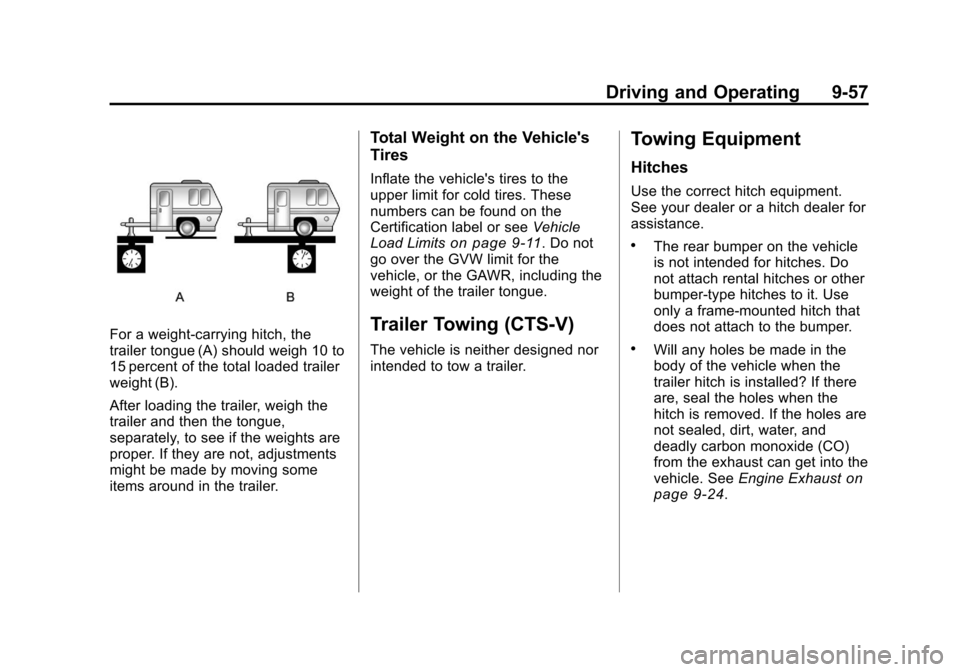
Black plate (57,1)Cadillac CTS/CTS-V Owner Manual - 2011
Driving and Operating 9-57
For a weight-carrying hitch, the
trailer tongue (A) should weigh 10 to
15 percent of the total loaded trailer
weight (B).
After loading the trailer, weigh the
trailer and then the tongue,
separately, to see if the weights are
proper. If they are not, adjustments
might be made by moving some
items around in the trailer.
Total Weight on the Vehicle's
Tires
Inflate the vehicle's tires to the
upper limit for cold tires. These
numbers can be found on the
Certification label or seeVehicle
Load Limits
on page 9‑11. Do not
go over the GVW limit for the
vehicle, or the GAWR, including the
weight of the trailer tongue.
Trailer Towing (CTS-V)
The vehicle is neither designed nor
intended to tow a trailer.
Towing Equipment
Hitches
Use the correct hitch equipment.
See your dealer or a hitch dealer for
assistance.
.The rear bumper on the vehicle
is not intended for hitches. Do
not attach rental hitches or other
bumper-type hitches to it. Use
only a frame-mounted hitch that
does not attach to the bumper.
.Will any holes be made in the
body of the vehicle when the
trailer hitch is installed? If there
are, seal the holes when the
hitch is removed. If the holes are
not sealed, dirt, water, and
deadly carbon monoxide (CO)
from the exhaust can get into the
vehicle. See Engine Exhaust
on
page 9‑24.
Page 319 of 496
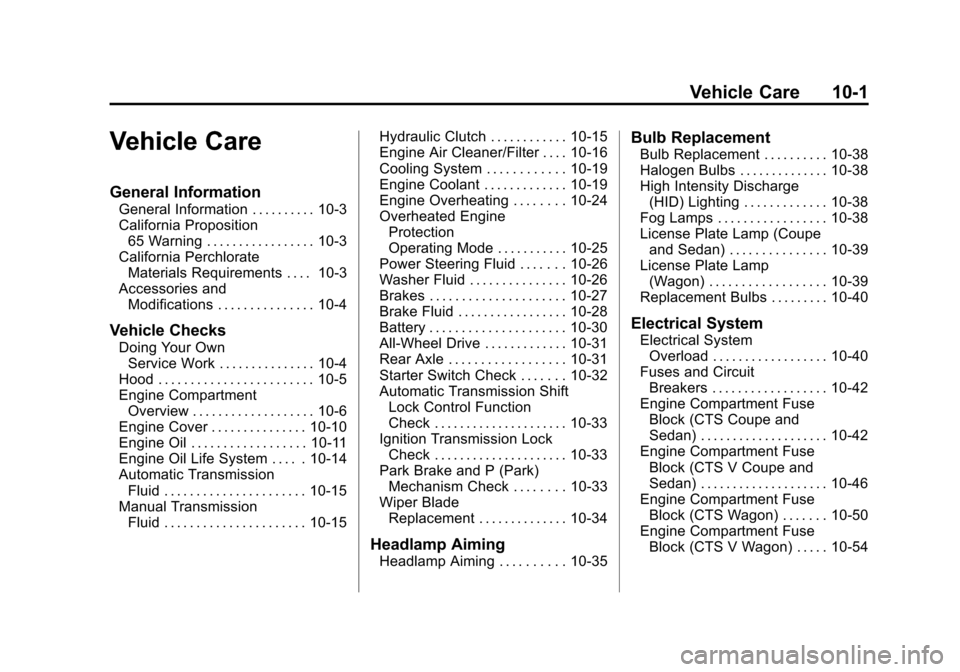
Black plate (1,1)Cadillac CTS/CTS-V Owner Manual - 2011
Vehicle Care 10-1
Vehicle Care
General Information
General Information . . . . . . . . . . 10-3
California Proposition65 Warning . . . . . . . . . . . . . . . . . 10-3
California Perchlorate Materials Requirements . . . . 10-3
Accessories and Modifications . . . . . . . . . . . . . . . 10-4
Vehicle Checks
Doing Your OwnService Work . . . . . . . . . . . . . . . 10-4
Hood . . . . . . . . . . . . . . . . . . . . . . . . 10-5
Engine Compartment Overview . . . . . . . . . . . . . . . . . . . 10-6
Engine Cover . . . . . . . . . . . . . . . 10-10
Engine Oil . . . . . . . . . . . . . . . . . . 10-11
Engine Oil Life System . . . . . 10-14
Automatic Transmission Fluid . . . . . . . . . . . . . . . . . . . . . . 10-15
Manual Transmission Fluid . . . . . . . . . . . . . . . . . . . . . . 10-15 Hydraulic Clutch . . . . . . . . . . . . 10-15
Engine Air Cleaner/Filter . . . . 10-16
Cooling System . . . . . . . . . . . . 10-19
Engine Coolant . . . . . . . . . . . . . 10-19
Engine Overheating . . . . . . . . 10-24
Overheated Engine
Protection
Operating Mode . . . . . . . . . . . 10-25
Power Steering Fluid . . . . . . . 10-26
Washer Fluid . . . . . . . . . . . . . . . 10-26
Brakes . . . . . . . . . . . . . . . . . . . . . 10-27
Brake Fluid . . . . . . . . . . . . . . . . . 10-28
Battery . . . . . . . . . . . . . . . . . . . . . 10-30
All-Wheel Drive . . . . . . . . . . . . . 10-31
Rear Axle . . . . . . . . . . . . . . . . . . 10-31
Starter Switch Check . . . . . . . 10-32
Automatic Transmission Shift Lock Control Function
Check . . . . . . . . . . . . . . . . . . . . . 10-33
Ignition Transmission Lock Check . . . . . . . . . . . . . . . . . . . . . 10-33
Park Brake and P (Park) Mechanism Check . . . . . . . . 10-33
Wiper Blade Replacement . . . . . . . . . . . . . . 10-34
Headlamp Aiming
Headlamp Aiming . . . . . . . . . . 10-35
Bulb Replacement
Bulb Replacement . . . . . . . . . . 10-38
Halogen Bulbs . . . . . . . . . . . . . . 10-38
High Intensity Discharge(HID) Lighting . . . . . . . . . . . . . 10-38
Fog Lamps . . . . . . . . . . . . . . . . . 10-38
License Plate Lamp (Coupe
and Sedan) . . . . . . . . . . . . . . . 10-39
License Plate Lamp (Wagon) . . . . . . . . . . . . . . . . . . 10-39
Replacement Bulbs . . . . . . . . . 10-40
Electrical System
Electrical System Overload . . . . . . . . . . . . . . . . . . 10-40
Fuses and Circuit Breakers . . . . . . . . . . . . . . . . . . 10-42
Engine Compartment Fuse
Block (CTS Coupe and
Sedan) . . . . . . . . . . . . . . . . . . . . 10-42
Engine Compartment Fuse Block (CTS V Coupe and
Sedan) . . . . . . . . . . . . . . . . . . . . 10-46
Engine Compartment Fuse Block (CTS Wagon) . . . . . . . 10-50
Engine Compartment Fuse Block (CTS V Wagon) . . . . . 10-54
Page 321 of 496
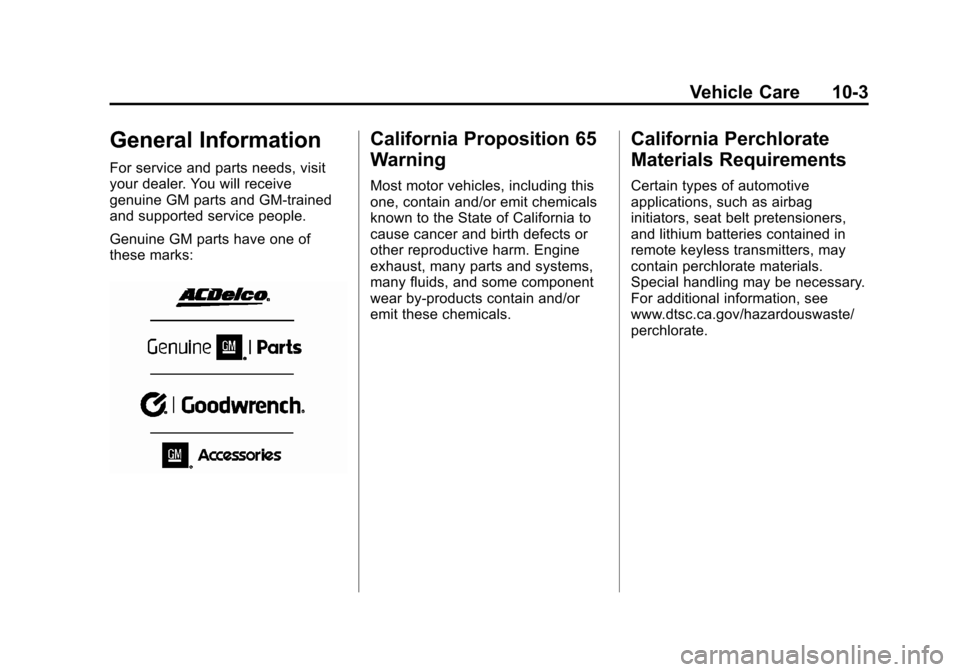
Black plate (3,1)Cadillac CTS/CTS-V Owner Manual - 2011
Vehicle Care 10-3
General Information
For service and parts needs, visit
your dealer. You will receive
genuine GM parts and GM-trained
and supported service people.
Genuine GM parts have one of
these marks:
California Proposition 65
Warning
Most motor vehicles, including this
one, contain and/or emit chemicals
known to the State of California to
cause cancer and birth defects or
other reproductive harm. Engine
exhaust, many parts and systems,
many fluids, and some component
wear by-products contain and/or
emit these chemicals.
California Perchlorate
Materials Requirements
Certain types of automotive
applications, such as airbag
initiators, seat belt pretensioners,
and lithium batteries contained in
remote keyless transmitters, may
contain perchlorate materials.
Special handling may be necessary.
For additional information, see
www.dtsc.ca.gov/hazardouswaste/
perchlorate.
Page 324 of 496
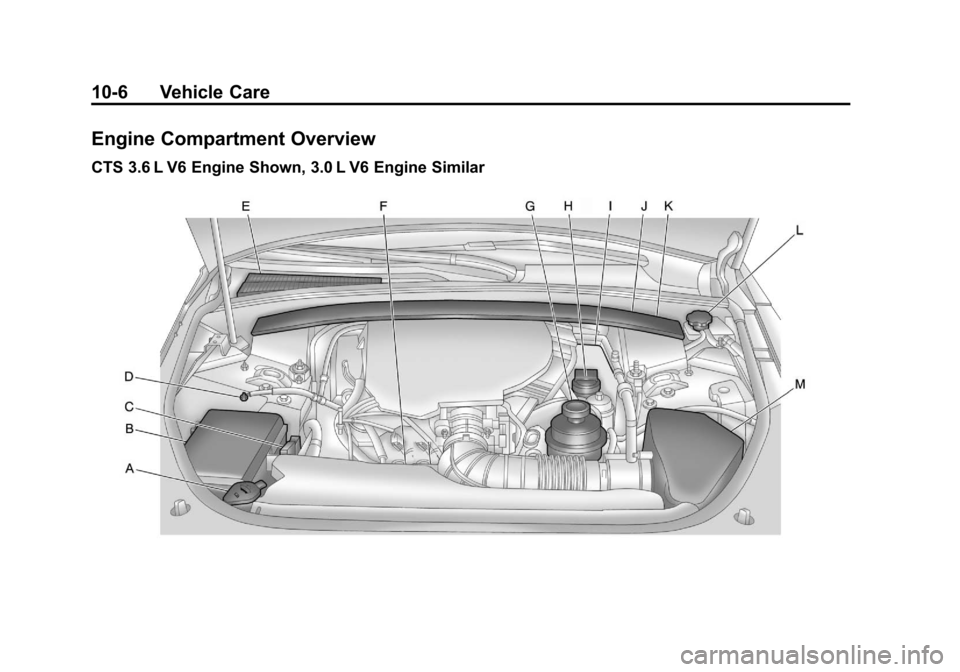
Black plate (6,1)Cadillac CTS/CTS-V Owner Manual - 2011
10-6 Vehicle Care
Engine Compartment Overview
CTS 3.6 L V6 Engine Shown, 3.0 L V6 Engine Similar
Page 325 of 496

Black plate (7,1)Cadillac CTS/CTS-V Owner Manual - 2011
Vehicle Care 10-7
A. Windshield Washer FluidReservoir. See Washer Fluidon
page 10‑26.
B. Engine Compartment Fuse
Block (CTS Coupe and Sedan)
on page 10‑42orEngine
Compartment Fuse Block (CTS
V Coupe and Sedan)
on
page 10‑46or Engine
Compartment Fuse Block (CTS
Wagon)
on page 10‑50or
Engine Compartment Fuse
Block (CTS V Wagon)
on
page 10‑54.
C. Remote Positive (+) Terminal. See Jump Starting
on
page 10‑112. D. Remote Negative (−) Terminal.
See Jump Starting
on
page 10‑112.
E. Passenger Compartment Air Filter. See Passenger
Compartment Air Filter
on
page 8‑6.
F. Engine Cooling Fan (Out of View). See Cooling System
on
page 10‑19.
G. Power Steering Fluid Reservoir (Under Engine Cover). See
Power Steering Fluid
on
page 10‑26.
H. Engine Oil Fill Cap. See Engine
Oil on page 10‑11. I. Engine Oil Dipstick (Out of
View). See Engine Oil
on
page 10‑11.
J. Hydraulic Clutch Reservoir (If Equipped) (Not Shown). See
Hydraulic Clutch on page 10‑15.
K. Brake Master Cylinder Reservoir (Out of View). See
Brakes on page 10‑27.
L. Engine Coolant Surge Tank and Pressure Cap. See Engine
Coolant on page 10‑19.
M. Engine Air Cleaner/Filter
on
page 10‑16.
Page 326 of 496
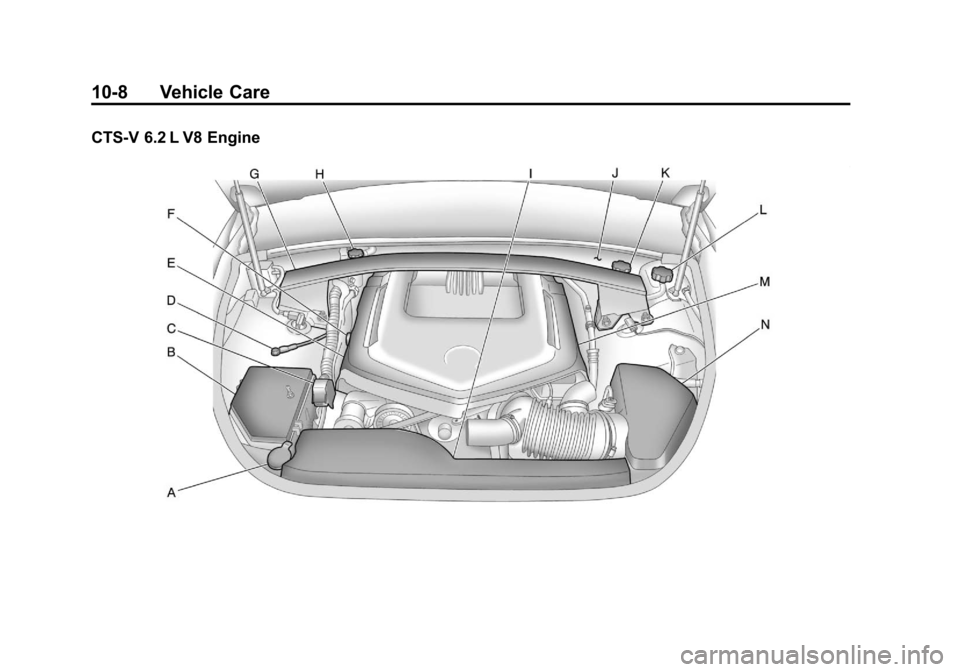
Black plate (8,1)Cadillac CTS/CTS-V Owner Manual - 2011
10-8 Vehicle Care
CTS-V 6.2 L V8 Engine
Page 327 of 496

Black plate (9,1)Cadillac CTS/CTS-V Owner Manual - 2011
Vehicle Care 10-9
A. Windshield Washer FluidReservoir. See Washer Fluidon
page 10‑26.
B. Engine Compartment Fuse
Block (CTS Coupe and Sedan)
on page 10‑42orEngine
Compartment Fuse Block (CTS
V Coupe and Sedan)
on
page 10‑46or Engine
Compartment Fuse Block (CTS
Wagon)
on page 10‑50or
Engine Compartment Fuse
Block (CTS V Wagon)
on
page 10‑54.
C. Remote Positive (+) Terminal. See Jump Starting
on
page 10‑112. D. Remote Negative (−) Terminal.
See Jump Starting
on
page 10‑112.
E. Engine Oil Fill Cap (Out of View). See Engine Oil
on
page 10‑11.
F. Engine Oil Dipstick. See Engine
Oil on page 10‑11.
G. Passenger Compartment Air Filter. See Passenger
Compartment Air Filter
on
page 8‑6.
H. Intercooler System Pressure Cap. See Cooling System
on
page 10‑19.
I. Engine Cooling Fans (Out of View). See Cooling System
on
page 10‑19. J. Hydraulic Clutch Reservoir
(If Equipped) (Not Shown). See
Hydraulic Clutch on page 10‑15.
K. Brake Master Cylinder Reservoir. See Brakes
on
page 10‑27.
L. Engine Coolant Surge Tank and Pressure Cap. See Engine
Coolant on page 10‑19.
M. Power Steering Fluid Reservoir (Under Engine Cover). See
Power Steering Fluid
on
page 10‑26.
N. Engine Air Cleaner/Filter
on
page 10‑16.
Page 328 of 496
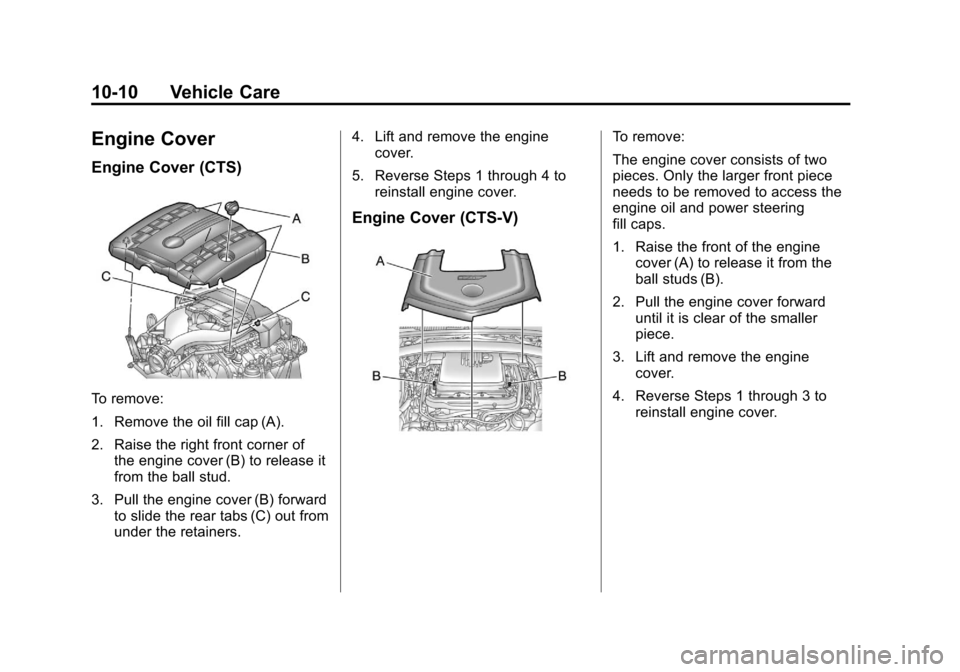
Black plate (10,1)Cadillac CTS/CTS-V Owner Manual - 2011
10-10 Vehicle Care
Engine Cover
Engine Cover (CTS)
To remove:
1. Remove the oil fill cap (A).
2. Raise the right front corner ofthe engine cover (B) to release it
from the ball stud.
3. Pull the engine cover (B) forward to slide the rear tabs (C) out from
under the retainers. 4. Lift and remove the engine
cover.
5. Reverse Steps 1 through 4 to reinstall engine cover.
Engine Cover (CTS-V)
To remove:
The engine cover consists of two
pieces. Only the larger front piece
needs to be removed to access the
engine oil and power steering
fill caps.
1. Raise the front of the enginecover (A) to release it from the
ball studs (B).
2. Pull the engine cover forward until it is clear of the smaller
piece.
3. Lift and remove the engine cover.
4. Reverse Steps 1 through 3 to reinstall engine cover.
Page 329 of 496
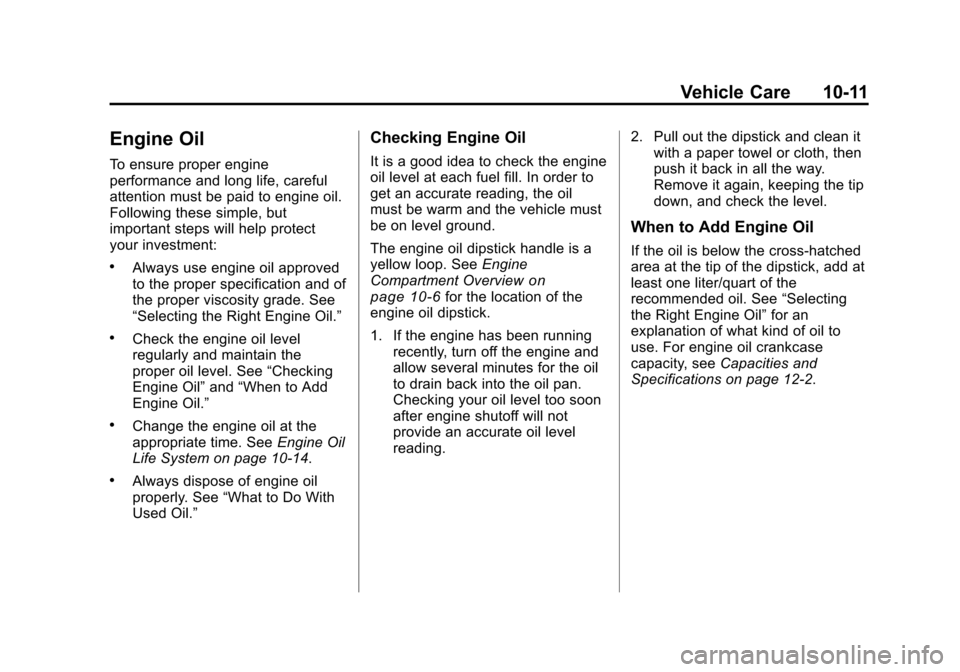
Black plate (11,1)Cadillac CTS/CTS-V Owner Manual - 2011
Vehicle Care 10-11
Engine Oil
To ensure proper engine
performance and long life, careful
attention must be paid to engine oil.
Following these simple, but
important steps will help protect
your investment:
.Always use engine oil approved
to the proper specification and of
the proper viscosity grade. See
“Selecting the Right Engine Oil.”
.Check the engine oil level
regularly and maintain the
proper oil level. See“Checking
Engine Oil” and“When to Add
Engine Oil.”
.Change the engine oil at the
appropriate time. See Engine Oil
Life System on page 10‑14.
.Always dispose of engine oil
properly. See “What to Do With
Used Oil.”
Checking Engine Oil
It is a good idea to check the engine
oil level at each fuel fill. In order to
get an accurate reading, the oil
must be warm and the vehicle must
be on level ground.
The engine oil dipstick handle is a
yellow loop. See Engine
Compartment Overview
on
page 10‑6for the location of the
engine oil dipstick.
1. If the engine has been running
recently, turn off the engine and
allow several minutes for the oil
to drain back into the oil pan.
Checking your oil level too soon
after engine shutoff will not
provide an accurate oil level
reading. 2. Pull out the dipstick and clean it
with a paper towel or cloth, then
push it back in all the way.
Remove it again, keeping the tip
down, and check the level.
When to Add Engine Oil
If the oil is below the cross-hatched
area at the tip of the dipstick, add at
least one liter/quart of the
recommended oil. See “Selecting
the Right Engine Oil” for an
explanation of what kind of oil to
use. For engine oil crankcase
capacity, see Capacities and
Specifications on page 12‑2.
Page 330 of 496
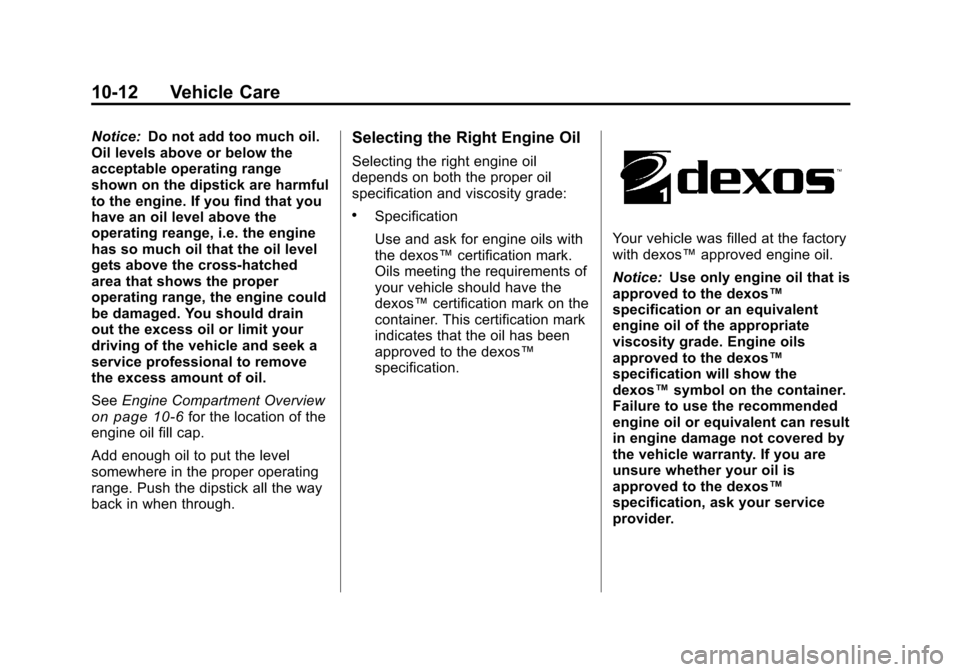
Black plate (12,1)Cadillac CTS/CTS-V Owner Manual - 2011
10-12 Vehicle Care
Notice:Do not add too much oil.
Oil levels above or below the
acceptable operating range
shown on the dipstick are harmful
to the engine. If you find that you
have an oil level above the
operating reange, i.e. the engine
has so much oil that the oil level
gets above the cross-hatched
area that shows the proper
operating range, the engine could
be damaged. You should drain
out the excess oil or limit your
driving of the vehicle and seek a
service professional to remove
the excess amount of oil.
See Engine Compartment Overview
on page 10‑6for the location of the
engine oil fill cap.
Add enough oil to put the level
somewhere in the proper operating
range. Push the dipstick all the way
back in when through.
Selecting the Right Engine Oil
Selecting the right engine oil
depends on both the proper oil
specification and viscosity grade:
.Specification
Use and ask for engine oils with
the dexos™ certification mark.
Oils meeting the requirements of
your vehicle should have the
dexos™ certification mark on the
container. This certification mark
indicates that the oil has been
approved to the dexos™
specification.
Your vehicle was filled at the factory
with dexos™ approved engine oil.
Notice: Use only engine oil that is
approved to the dexos™
specification or an equivalent
engine oil of the appropriate
viscosity grade. Engine oils
approved to the dexos™
specification will show the
dexos™ symbol on the container.
Failure to use the recommended
engine oil or equivalent can result
in engine damage not covered by
the vehicle warranty. If you are
unsure whether your oil is
approved to the dexos™
specification, ask your service
provider.